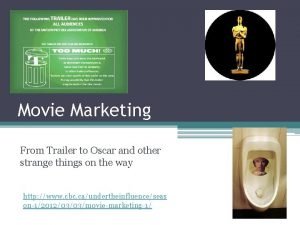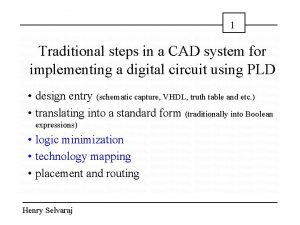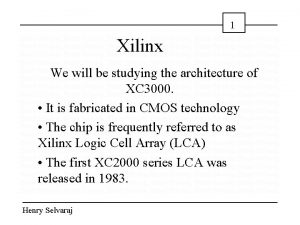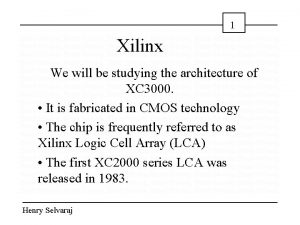Lesson 2 Cars Credit and Movies Cars Henry


















- Slides: 18

Lesson 2 Cars, Credit, and Movies

Cars Henry Ford was born July 30, 1863 and grew up in Michigan In 1891, Ford became an engineer with the Edison Illuminating company in Detroit He began experimenting with internal combustion engines.

These experiments culminated in 1896 with the completion of his own selfpropelled vehicle-the Quadricycle. The Quadricycle had four wire wheels that looked like heavy bicycle wheels, was steered with a tiller like a boat, and had only two forward speeds with no reverse.

After two unsuccessful attempts to establish a company to manufacture automobiles, the Ford Motor Company was incorporated in 1903 with Henry Ford as vice-president and chief engineer. The infant company produced only a few cars a day at the Ford factory on Mack Avenue in Detroit. Groups of two or three men worked on each car from components made to order by other companies.

By 1918, half of all cars in America were Model Ts. To meet the growing demand for the Model T, the company opened a large factory at Highland Park, Michigan, in 1910. Here, Henry Ford combined precision manufacturing, standardized and interchangeable parts, a division of labor, and, in 1913, a continuous moving assembly line. Workers remained in place, adding one component to each automobile as it moved past them on the line.

Delivery of parts by conveyor belt to the workers was carefully timed to keep the assembly line moving smoothly and efficiently. The introduction of the moving assembly line revolutionized automobile production by significantly reducing assembly time per vehicle, thus lowering costs.


Credit Everything came together in the 1920 s: mass production, electrification, highway construction, mass communication, the expansion of consumer financing. Auto manufacturers perfected assembly line production and began to turn out cars at a price that would “put the middle class on wheels”.

Public investment in a federal highway system helped to expand the market even further. Other manufacturers adapted assembly line techniques to produce affordable home appliances and consumer electronics: ovens, refrigerators, washing machines, phonographs, radios, telephones. And investment in the utility infrastructure electrical power grid, phone lines, water and sewer systems - helped to bring these products into more homes.

But the catalyst - the thing that helped to bring all these industrial and technological marvels within the reach of so many consumers - was the expanded use of installment credit. The big breakthrough came in 1919 when General Motors Acceptance Corporation (GMAC) became the first to make financing available to middle-income car buyers. Instead of having to come up with the entire purchase price, prospective car buyers needed only a down payment and an income that was big enough to cover monthly payments over the life of the loan.

Before long, manufacturers of other “big ticket” items began to adopt the practice. And if consumers were hesitant to go into debt, the flood of advertisements in mass media outlets - newspapers, magazines, and radio - helped them to overcome their inhibitions.

During the early years of the 20 th century, a few hotels issued credit cards to favored guests, but the cards were mainly a gimmick - status symbols that distinguished the cardholders from the masses of cash-paying customers. Retail stores and oil companies were issuing credit cards during the 1920 s, but they were single-party cards issued by merchants who saw them as a way to sell more goods and services.

They offered cardholders a certain measure of convenience but very little flexibility. Department store cards weren’t accepted by competitors, and unless they were issued by a national chain, they weren’t much use when traveling. Gasoline credit cards covered a wider market area, but they weren’t accepted by competitors, nor were they much use if you needed something that wasn’t sold at a gas station.

Movies By the mid-20 s, movies were big business (with a capital investment totaling over $2 billion) with some theatres offering double features. By the end of the decade, there were 20 Hollywood studios, and the demand for films was greater than ever. Most people are unaware that the greatest output of feature films in the US occurred in the 1920 s and 1930 s (averaging about 800 film releases in a year) - nowadays, it is remarkable when production exceeds 500 films in a year.

Throughout most of the decade, silent films were the predominant product of the film industry, having evolved from vaudevillian roots. – Vaudeville: stage variety show, with singing, dancing, comedy skits, and animal acts; highly popular in America from the late 1880 s to the 1930 s But the films were becoming bigger (or longer), costlier, and more polished. They were being manufactured, assembly-line style, in Hollywood's 'entertainment factories, ' in which production was broken down and organized into its various components (writing, costuming, makeup, directing, etc. ).

Experimentation with sound film technology, both for recording and playback, was virtually constant throughout the silent era, but the twin problems of accurate synchronization and sufficient amplification had been difficult to overcome. In 1926, Hollywood studio Warner Bros. introduced the "Vitaphone" system, producing short films of live entertainment acts and public figures and adding recorded sound effects and orchestral scores to some of its major features.

The real turning point came in late 1927, when Warners released The Jazz Singer, which was mostly silent but contained the first synchronized dialogue (and singing) in a feature film. The change was remarkably swift. By the end of 1929, Hollywood was almost all-talkie, with several competing sound systems (soon to be standardized).

Creatively, however, the lightning-paced transition was a difficult one, and in some ways, film briefly reverted to the conditions of its earliest days. The late '20 s were full of static, stagey talkies as artists in front of and behind the camera struggled with the stringent limitations of the early sound equipment and their own uncertainty as to how to utilize the new medium. Stage performers, directors and writers flooded the cinema as producers sought personnel experienced in dialogue-based storytelling. Many major silent filmmakers and actors were unable to adjust and found their careers severely curtailed or even suddenly over.
 This can be avoided by giving credit where credit is due.
This can be avoided by giving credit where credit is due. Tone examples in movies
Tone examples in movies Why we crave horror movies questions
Why we crave horror movies questions Memory moment picture books
Memory moment picture books Self concept attachment
Self concept attachment Lesson eight credit cards
Lesson eight credit cards Lesson nine credit card charge
Lesson nine credit card charge When was film invented
When was film invented Understanding movies 14th edition
Understanding movies 14th edition Protagonist examples
Protagonist examples Is watching films a hobby
Is watching films a hobby Mother archetype definition
Mother archetype definition The drive in movies by gary soto
The drive in movies by gary soto Symbolic convergence examples
Symbolic convergence examples Movie marketing trailers
Movie marketing trailers Disney movies jeopardy
Disney movies jeopardy Orchard 14 marquee
Orchard 14 marquee Looking at movies 4th edition
Looking at movies 4th edition Jerry spinelli movies
Jerry spinelli movies



































